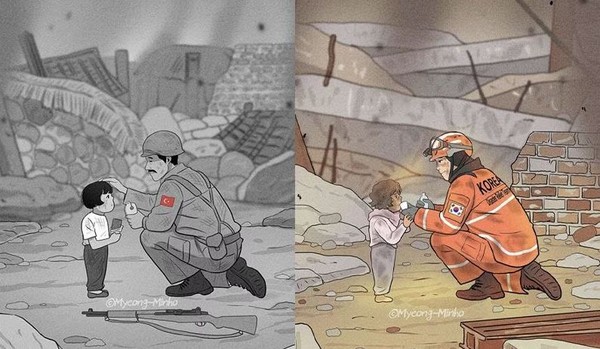Over the tragic earthquake in Turkey
On Feb. 10, 2023, Korean Cartoon illustrator Myung Min-ho presented two pictures. One showing Turkish soldier caring for a Korean War orphan and other with Korean earthquake worker comforting a Turkish child.
The Turkish soldier in the painting is stroking the child's head kneading down in a war-torn place. He also has a drink in his other hand. Similarly, South Korea's emergency rescue worker is kneeling at a site in Turkey collapsed by the earthquake and giving drinks to the child.

"I was impressed by the news that the Korean rescue team was active (in Turkey) on Feb. 10, 2023 so I drew a picture," Author Myung said in an interview with Korean-language newspaper, Chosun Ilbo. "I worked with condolences after hearing the news of many casualties in Turkey and Syria."
Cartoon illustrator Myung said, "I drew the picture in the hope that the hearts of Turkish people will not collapse through painting. In particular, I wanted to show that I did not forget my gratitude to Turkey, a country of brothers who helped and made great sacrifices to our country during the Korean War."
The number of earthquake deaths in both Turkey and Syria as of Feb. 13 was estimated to be more than 33,000.
South Korea and Turkey are so-called ‘Blood-forged Allies’ as Turkey sent her combat troops to Korea to fight on the side of the (ROK) against the North Korean and Chinese invasions forces during the Korean War (1950-3).
At this time, Turkey is having a very hard time due to disastrous earthquakes in the country and now it is Korea’s turn to go to help the country under distress.
The Turkish Brigade (North Star), according to the Wikipedia encyclopedia, was an infantry brigade of the Turkish Army.
Turkey was one of 22 countries to contribute manpower to U.N. forces, and one of sixteen to provide military personnel. The first 5,000 troops of the Turkish Brigade arrived on Oct. 19, 1950, shortly after the outbreak of the Korean War on June 25 that year, and remained in varying strengths until the summer of 1954. Attached to the U.S. 25th Infantry Division, the Turkish Brigade was the only U.N. unit of its size permanently attached to a U.S. division throughout the Korean War.
The Turkish Brigade took part in several actions, most notably in the Battle of Kunuri, where their fierce resistance was decisive in delaying the enemy advance. Its actions earned the brigade Unit Citations from Korea and the U.S., and it subsequently developed a reputation for its fighting ability, stubborn defense, commitment to mission, and bravery.
On June 29, 1950, Turkey replied to the United Nations Resolution 83 requesting military aid to the ROK, following the attack by North Korea on 25 June. The cable stated: "Turkey is ready to meet his responsibilities." On July 25, 1950 Turkey decided to send a brigade, comprising three infantry battalions, an artillery battalion and auxiliary units, to fight under UN Command against North Korea and subsequently the People's Republic of China. Turkey was the second country to answer the UN call, after the United States.
Members of the Turkish Brigade move into position in December 1950, shortly after suffering severe casualties attempting to block encirclement of the U.S. 2nd Division at the Cheongcheon River in North Korea.
Three different Turkish Brigades served in the Korean War. The core of the 1st Turkish Brigade was the 241st Infantry Regiment based at Aya?, which was supplemented with volunteers to raise it to brigade level. Brigadier General Tahsin Yaz©¥c©¥, a veteran of the Gallipoli Campaign, commanded the 1st Brigade.
The 1st Turkish Brigade consisted of three battalions, commanded by Major Imadettin Kuranel, Major Mithat Ulunu, and Major Lutfu Bilgon. The Turkish Armed Forces Command (TAFC) was a regimental combat team with three infantry battalions, along with supporting artillery and engineers. It was the only brigade-sized unit attached permanently to a U.S. division throughout the Korean War.
Brigadier General Tahsin Yazici was highly regarded in the Turkish military establishment. He stepped down a rank in order to command the first contingent of Turks in the Korean War. While there were cultural and religious differences between Turkish and American troops, both were disciplined forces capable of adapting.
The brigade had a full turnover after a period of one year's service. During the service of the 3rd Brigade in 1953, the Korean Armistice was signed. Thereafter, Turkey continued maintaining forces at full brigade level for another seven years, in accordance with United Nations agreements. Kenan Evren, the seventh President of the Republic of Turkey, served in the Brigade from 1958 until 1959.
The advance party of the Turkish Brigade arrived in Busan on Oct. 12, 1950. The main body arrived five days later, October 17 from the eastern Mediterranean port of Iskenderun, Turkey, and the brigade went into bivouac near Taegu where it underwent training and received U.S. equipment. The brigade was attached to the U.S. 25th Infantry Division.
United Nations Forces Commander in Chief, General Douglas MacArthur, highly praised the gallantry and valuable contributions made by the Turkish Brigade.

